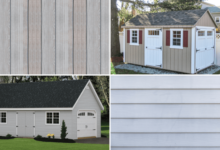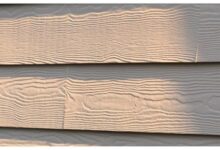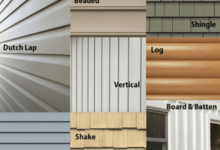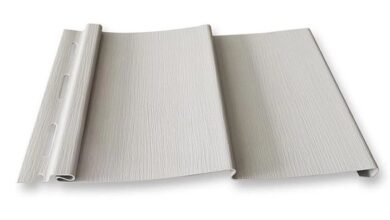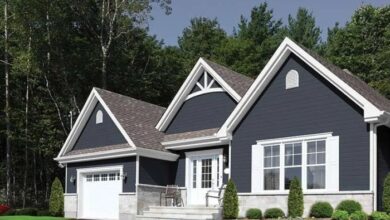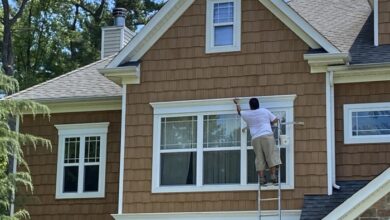Stone Veneer Siding A Comprehensive Guide
Stone veneer siding elevates home exteriors, offering a blend of natural beauty and lasting durability. This detailed exploration delves into the multifaceted world of stone veneer, from its manufacturing process and diverse material options to its installation, maintenance, and aesthetic applications. We’ll uncover cost-effective strategies, explore its environmental impact, and showcase stunning design examples that inspire creativity and innovation.
Prepare to discover the transformative power of stone veneer and how it can enhance your next project.
We’ll cover everything from choosing the right type of stone and understanding installation techniques to budgeting effectively and minimizing environmental impact. Learn how to maximize the aesthetic appeal of your home or commercial building with this versatile and enduring cladding solution. Whether you’re a seasoned professional or a DIY enthusiast, this guide will equip you with the knowledge you need to make informed decisions.
Introduction to Stone Veneer Siding
Stone veneer siding offers a captivating blend of natural beauty and durability, transforming homes into stunning architectural masterpieces. Its increasing popularity stems from its versatility, relatively easy installation, and the timeless appeal of natural stone. This detailed overview explores the manufacturing process, diverse stone types, advantages, and common architectural applications of this increasingly sought-after building material.Stone veneer siding manufacturing involves a multi-step process.
First, natural stone is quarried and then cut into thin, manageable pieces, typically ranging from 1/2 inch to 1 1/2 inches thick. These pieces undergo a rigorous quality control process, ensuring consistent size and texture. Next, they’re often treated with protective sealants to enhance durability and weather resistance. Finally, the veneers are packaged and prepared for distribution, ready to be installed on various building exteriors.
The entire process prioritizes minimizing waste and maximizing the utilization of the natural stone.
Types of Stone Used in Veneer Siding
The selection of stone significantly impacts the final aesthetic and performance of the veneer. A wide variety of natural stones are employed, each offering unique visual characteristics and properties. Popular choices include granite, known for its exceptional strength and resistance to weathering; limestone, prized for its subtle, earthy tones and texture; and sandstone, which provides a more rustic and traditional appearance.
Other options include slate, travertine, and quartzite, each contributing a distinct visual character to a building’s exterior. The choice ultimately depends on factors like budget, desired aesthetic, and regional climate.
Advantages of Stone Veneer Siding
Compared to other siding materials like vinyl or wood, stone veneer offers several compelling advantages. Its exceptional durability ensures longevity, withstanding harsh weather conditions and resisting damage from insects or rot. Furthermore, stone veneer boasts superior fire resistance, contributing to enhanced home safety. From an aesthetic perspective, its natural beauty adds significant curb appeal and increases property value, making it a smart investment.
Finally, its low maintenance requirements translate to long-term cost savings. For instance, unlike wood siding that requires regular painting or staining, stone veneer generally needs minimal upkeep.
Architectural Styles Where Stone Veneer Siding Is Commonly Used
Stone veneer’s versatility allows for seamless integration into a broad range of architectural styles. It is particularly well-suited for traditional styles like Colonial, Tudor, and Craftsman homes, where its inherent elegance complements the classic architectural details. However, its adaptability extends to more modern designs as well. Contemporary homes can benefit from stone veneer’s textural contrast and ability to create striking visual focal points.
For example, a modern farmhouse might incorporate stone veneer around the base, creating a visually grounding element that balances the clean lines of the upper structure. The inherent adaptability of stone veneer makes it a popular choice for designers seeking to enhance the visual impact and longevity of a variety of architectural styles.
Installation and Maintenance of Stone Veneer Siding
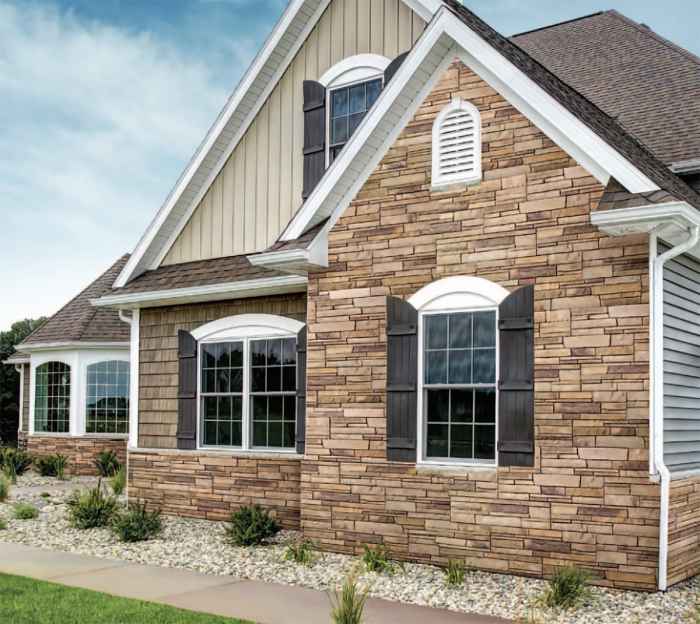
Stone veneer siding offers a beautiful, durable, and relatively low-maintenance exterior for your home. However, achieving a long-lasting, attractive finish requires careful installation and consistent upkeep. This section details the process of installation, highlights common pitfalls to avoid, and provides a comprehensive maintenance plan to keep your stone veneer looking its best for years to come.
Step-by-Step Stone Veneer Siding Installation
Proper installation is crucial for the longevity and aesthetic appeal of your stone veneer. A methodical approach, using the right tools and materials, will yield superior results. The following table Artikels the key steps involved.
| Step | Tools | Materials | Description |
|---|---|---|---|
| 1. Preparation | Measuring tape, level, chalk line, safety glasses | Underlayment, furring strips (if needed), construction adhesive | Ensure a clean, level surface. Install underlayment for moisture protection and furring strips to create a consistent air gap behind the veneer. |
| 2. Corner Installation | Mortar trowel, pointing trowel, bucket, sponge | Mortar mix, stone veneer | Begin at a corner, applying mortar to the back of the stone and pressing it firmly against the wall. Ensure proper alignment and spacing. |
| 3. Laying the Veneer | Rubber mallet, level, safety glasses | Stone veneer, mortar mix | Continue laying the veneer, applying mortar to both the back of the stone and the wall for maximum adhesion. Use a level to check for consistent alignment. |
| 4. Grouting and Finishing | Grout bag, pointing trowel, sponge, brush | Mortar mix (grout), sealant | Once the mortar has set, apply grout to fill the gaps between stones. Clean excess grout and apply a sealant to protect the veneer from moisture. |
Common Installation Mistakes and Their Prevention
Several common mistakes can compromise the integrity and appearance of stone veneer siding. Understanding these issues and implementing preventative measures is vital for a successful installation. For example, using insufficient mortar can lead to loose stones and potential damage. Always follow manufacturer’s recommendations for mortar application. Another frequent error is neglecting proper alignment and spacing, resulting in an uneven and unattractive finish.
Consistent use of a level and careful planning are essential. Finally, failing to adequately protect the veneer during and after installation can lead to damage from weather or accidental impacts. Proper covering and post-installation sealing are therefore crucial.
Stone Veneer Siding Maintenance
Regular maintenance is key to preserving the beauty and longevity of your stone veneer siding. This involves routine cleaning to remove dirt, debris, and mildew, and prompt repair of any damaged stones. Cleaning should be performed at least annually, using a soft-bristled brush and a mild detergent solution. Pressure washing should be avoided as it can damage the veneer.
For repairs, replace damaged stones with matching pieces, using appropriate mortar and ensuring proper adhesion.
Protecting Stone Veneer Siding from Weather Damage
Stone veneer, while durable, is susceptible to damage from extreme weather conditions. Protecting it from the elements is crucial for its longevity. Regularly inspect the siding for cracks or loose stones, addressing any issues promptly. Consider using a high-quality sealant to further protect the veneer from moisture penetration. Proper drainage around the foundation is also essential to prevent water accumulation against the siding.
In areas prone to severe weather, strategic landscaping can help to shield the siding from harsh winds and driving rain. For example, planting shrubs or trees can provide a natural buffer.
Cost and Budgeting for Stone Veneer Siding
Choosing stone veneer siding significantly impacts your home’s aesthetic and value. However, understanding the associated costs is crucial for successful project planning and execution. This section provides a detailed breakdown of budgeting for a stone veneer siding project, including influencing factors and cost-saving strategies.
Sample Budget Breakdown for Stone Veneer Siding
A realistic budget is paramount. The following table provides a sample breakdown for a typical 1,500 square foot home, acknowledging that costs can vary significantly based on location, material choice, and labor rates. Always obtain multiple quotes from reputable contractors.
| Labor | Materials | Permits | Contingency |
|---|---|---|---|
| $8,000 – $12,000 | $10,000 – $15,000 | $500 – $1,000 | $2,000 – $3,000 |
Factors Influencing the Overall Cost of Stone Veneer Siding
Several key factors determine the final cost. These include the type of stone chosen (natural vs. manufactured), the complexity of the installation (e.g., intricate designs or challenging architectural features), the region’s labor costs, and the overall square footage of the area to be covered. For instance, high-end natural stones like granite or slate will command significantly higher prices than manufactured alternatives.
Similarly, a home with many angles and intricate details will necessitate more labor hours, driving up the cost.
Cost Comparison with Other Exterior Cladding Options
Stone veneer typically sits at a mid-range price point compared to other exterior cladding options. While less expensive than high-end brick or real stone, it’s generally more costly than vinyl or fiber cement siding. For example, vinyl siding might cost between $5,000 and $10,000 for a similar-sized home, while high-end brick could easily exceed $20,000. The precise cost difference will depend heavily on the specific materials and labor rates in your area.
Cost-Saving Strategies for Homeowners
Several strategies can help minimize expenses without sacrificing quality. Choosing manufactured stone veneer over natural stone can yield significant savings. Opting for a simpler design, minimizing intricate detailing, can reduce labor costs. Securing multiple quotes from contractors and negotiating prices is also crucial. Finally, undertaking some of the preparatory work, such as cleaning and preparing the walls, can potentially reduce the overall labor charges.
Remember, careful planning and research can result in significant cost savings without compromising the final result.
Design and Aesthetics of Stone Veneer Siding
Stone veneer siding offers a remarkable opportunity to enhance the curb appeal and overall aesthetic of any building. Its versatility allows for a wide range of design possibilities, transforming a house from ordinary to extraordinary. The careful selection of stone type, color, pattern, and integration with other materials significantly impacts the final look and feel, reflecting the homeowner’s personal style and the architectural vision.Stone veneer’s visual impact stems from its natural texture and inherent beauty.
Unlike manufactured materials, each piece possesses unique variations in color and form, adding character and depth to the façade. This natural variation contributes to the overall appeal, creating a timeless and sophisticated look that transcends fleeting trends.
Stone Veneer Siding Patterns and Textures
The diverse range of patterns and textures available in stone veneer provides architects and homeowners with a vast palette of design choices. Careful consideration of these elements significantly influences the overall visual impact of the building. The right pattern can subtly enhance architectural details or create a bold focal point.
- Ashlar Pattern: This classic pattern features rectangular or square stones laid in a regular, even arrangement, creating a clean, sophisticated look. Imagine a stately home with neatly aligned, light-grey ashlar stone veneer, complementing its symmetrical design.
- Random Ashlar Pattern: Similar to ashlar but with variations in stone size and placement, offering a more natural and less formal appearance. Picture a rustic cabin with a random ashlar pattern using a mix of browns and greys, emphasizing its cozy, informal character.
- Stacked Stone Pattern: This pattern uses long, thin stones stacked horizontally, creating a contemporary and sleek look. Think of a modern minimalist home with a dark grey stacked stone veneer accent wall, contrasting sharply with the clean lines of the structure.
- Rough-hewn Texture: This texture emphasizes the natural, unrefined character of the stone, often used to create a rustic or traditional aesthetic. A charming farmhouse, clad in rough-hewn stone veneer in earthy tones, perfectly embodies this style.
- Smooth Texture: A polished or smooth texture lends a more refined and elegant appearance, often used in contemporary or transitional designs. Visualize a sleek, modern townhome with smooth, light-beige stone veneer, showcasing its sophisticated design.
Color Choices and Their Impact
The color of the stone veneer significantly influences the overall mood and appearance of a building. Warm tones create a welcoming and inviting atmosphere, while cooler tones offer a more modern and sophisticated feel. The chosen color should complement the surrounding landscape and architectural style.
For example, a home nestled in a wooded area might benefit from earth tones like browns, tans, and greys, blending seamlessly with its natural surroundings. Conversely, a contemporary home in an urban setting might utilize cooler tones like greys, blues, or whites to create a sharp contrast against the cityscape. A coastal home could beautifully incorporate lighter, sandy hues, echoing the surrounding beach environment.
Stone Veneer Siding in Different Architectural Styles
Stone veneer is incredibly versatile and can be successfully integrated into a wide range of architectural styles. The choice of stone type, pattern, and color significantly impacts the final result.
Rustic designs often incorporate rough-hewn stones in warm earth tones, creating a cozy and inviting atmosphere. Traditional styles may utilize more formal patterns like ashlar, with colors chosen to complement the historical context. Modern designs frequently feature clean lines and sleek textures, often using stacked stone or smooth finishes in neutral or contrasting colors. A blend of styles can also be achieved; for example, a modern farmhouse could use a stacked stone base with a more rustic, rough-hewn stone accent wall.
Integrating Stone Veneer with Other Exterior Materials
The beauty of stone veneer lies in its ability to complement other exterior materials, creating a visually interesting and cohesive design. Strategic integration can enhance architectural features and add depth to the overall aesthetic.
Stone veneer can be paired effectively with wood siding, stucco, brick, or metal panels. For instance, a home might use stone veneer as an accent on the lower portion of the walls, with wood siding on the upper levels. Alternatively, stone veneer can be used to frame windows and doorways, creating visually striking focal points. The key is to choose materials that complement each other in terms of color, texture, and style, creating a harmonious and visually appealing exterior.
Environmental Impact and Sustainability
Stone veneer siding, while offering aesthetic appeal and durability, presents a complex environmental profile. Its impact stems from both the extraction and processing of the stone itself, as well as the transportation and installation processes. Understanding this lifecycle is crucial for making informed decisions about sustainable building practices.The environmental footprint of stone veneer siding is multifaceted. Manufacturing involves quarrying, which can lead to habitat disruption and landscape alteration.
Processing the stone requires energy for cutting, shaping, and potentially coloring or treating the material. Transportation adds to the carbon emissions, particularly if the stone originates from a distant location. Finally, installation involves the use of adhesives, sealants, and other materials that may have their own environmental impact. A comprehensive assessment considers these factors to determine the overall effect on the environment.
Lifecycle Assessment of Stone Veneer Siding
Comparing stone veneer to alternative materials like vinyl, fiber cement, or wood siding reveals significant differences in environmental impact. A lifecycle assessment (LCA) considers the energy used in manufacturing, transportation, installation, and eventual disposal or recycling. While the initial embodied carbon of stone might be higher than some alternatives, its significantly longer lifespan reduces the overall environmental burden over its operational lifetime.
For instance, a study comparing the LCA of stone veneer to vinyl siding showed that while vinyl’s manufacturing energy is lower, the shorter lifespan of vinyl necessitates more frequent replacements, ultimately resulting in a higher cumulative environmental impact over 50 years. The durability of stone reduces the frequency of replacement, mitigating long-term environmental costs.
Sustainability of Reclaimed or Recycled Stone
Utilizing reclaimed or recycled stone in veneer siding significantly reduces the environmental impact. Reclaimed stone, sourced from demolition projects or historical sites, avoids the need for new quarrying, reducing habitat disruption and minimizing energy consumption. Recycling stone waste from other construction projects into veneer also minimizes landfill waste and lowers the demand for newly quarried material. This approach aligns with circular economy principles, reducing the overall environmental burden of the building process.
For example, a project using reclaimed granite from a demolished bridge significantly reduced the carbon footprint of the new building’s facade.
Minimizing the Environmental Footprint of Stone Veneer Siding
Several strategies can help minimize the environmental impact of stone veneer siding projects. Sourcing stone locally reduces transportation distances and associated emissions. Selecting stones with low embodied energy and minimal processing requirements minimizes the manufacturing impact. Specifying low-VOC (volatile organic compound) adhesives and sealants reduces air pollution during and after installation. Careful planning and efficient installation techniques minimize waste generation.
Finally, considering the end-of-life management of the siding, such as potential reuse or recycling, contributes to a more sustainable approach. By prioritizing these factors, builders can significantly reduce the environmental burden associated with stone veneer siding projects.
Visual Representation of Stone Veneer Siding
Stone veneer siding offers a remarkable versatility in visual appeal, transforming the look of both residential and commercial properties. Its ability to mimic the texture and color of natural stone allows for a wide range of aesthetic possibilities, from rustic charm to modern elegance. Let’s explore how stone veneer transforms various architectural styles and settings.
Stone Veneer on a Suburban Home
Imagine a two-story colonial-style home nestled on a tree-lined street in a quiet suburban neighborhood. The house, painted a warm cream color, is accented by a rich, dark brown stone veneer siding that covers the lower half of the exterior walls. Landscaped flowerbeds overflowing with colorful blooms flank the front porch, which features a classic white railing and a charming rocking chair.
The stone veneer provides a strong visual foundation, contrasting beautifully with the lighter-colored upper story and complementing the lush green lawn and mature trees surrounding the property. The overall effect is one of timeless elegance and comfortable sophistication. The neighborhood itself reflects a sense of established community and well-maintained homes.
Close-up View of Stone Veneer Texture and Color
A closer examination reveals the intricate details of the stone veneer. The individual stones vary in size and shape, creating a naturally irregular pattern. The color palette ranges from deep browns and grays to subtle hints of beige and tan, with occasional flecks of lighter minerals adding depth and visual interest. The mortar between the stones is a carefully chosen shade of gray, blending seamlessly with the stone while providing a clean, defined separation.
The texture is rough and slightly uneven, offering a tactile quality that adds to the overall appeal. The surface shows subtle variations in tone and shading, mimicking the natural imperfections of real stone, creating a sense of authenticity and age.
Stone Veneer on a Commercial Building
A modern office building, showcasing clean lines and expansive windows, uses stone veneer as an accent feature. The large panels of light-grey stone veneer are strategically placed around the building’s base and along select columns, creating a striking contrast with the glass and steel facade. The scale of the stone veneer is impressive, emphasizing the building’s grandeur and solidity.
The consistent application and precise cuts of the stone create a polished and professional appearance, enhancing the building’s modern aesthetic. The large format of the stone panels offers a contemporary feel, differing from the smaller, more traditional applications found on residential buildings.
Mixed Stone Veneer Design Project
A recently completed renovation project features a stunning example of mixed stone veneer application. The exterior of a craftsman-style home showcases a blend of three different types of stone: a warm, earthy brown fieldstone for the main body, a lighter-colored limestone for accent strips around windows and doorways, and a darker, almost black slate for the chimney. The combination of these textures and colors creates a dynamic and visually captivating design.
The use of contrasting textures and colors adds depth and visual interest, showcasing the designer’s skill in creating a harmonious yet sophisticated look. The project demonstrates the potential of stone veneer to create unique and personalized architectural details. The result is a home that exudes both warmth and elegance, a testament to the transformative power of well-chosen materials.
Closing Notes
Stone veneer siding stands as a testament to timeless elegance and enduring strength. From its initial conception to its final installation, each stage offers opportunities to enhance both the visual appeal and the long-term value of your property. By carefully considering the various factors discussed – cost, aesthetics, environmental impact, and maintenance – you can make a well-informed decision that reflects your personal style and budgetary constraints.
Ultimately, stone veneer siding presents a winning combination of beauty, resilience, and enduring value, transforming homes and businesses into stunning showcases of architectural excellence.


